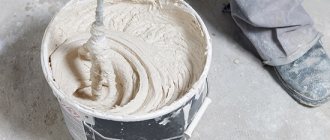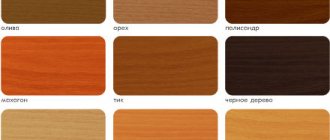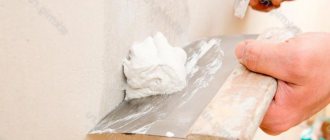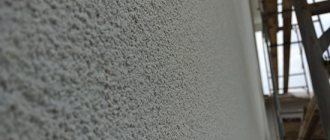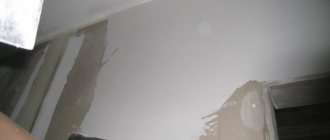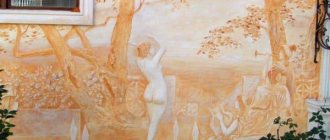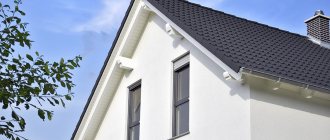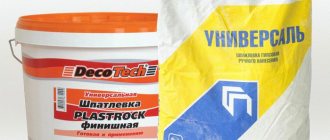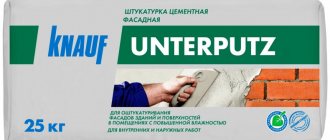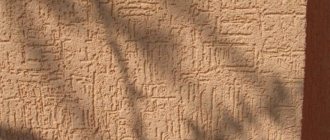Types of putty
Putty is a thick mass consisting of binding elements that, after hardening, form a durable surface. The main purpose of façade putty is to level out defects and fill small voids to create a smooth surface.
The putty is sold in the form of a dry and ready-mixed mixture. The disadvantage of the ready-made putty mixture is its limited shelf life and rapid hardening.
Depending on the purpose, putty is made from various materials:
- Cement based;
- Gypsum based;
- Acrylic;
- Latex;
- Oil glue.
When plastering, the following types of facade putty are used:
- Mineral;
- Acrylic;
- Silicate;
- Silicone.
Waterproof facade putty - designed to create a protective and decorative layer. Materials for the exterior decoration of buildings must have a certain list of properties.
Putty makes the surface strong, durable, resistant to seasonal temperature changes and precipitation.
An important role is played by a high level of adhesion, that is, the ability to stick to any material. Compatibility with any paint and varnish materials is a prerequisite when choosing a putty.
Due to the large surface area to be treated, preference is given to dry mixtures, which are mixed with water until the finished mass is obtained. According to reviews, cement-based façade putty is popular.
What you need to pay attention to when buying putty
In addition to the fact that the material must be resistant to mechanical and atmospheric influences, it must also have other important characteristics. When purchasing a material, it is necessary to take into account the characteristics that affect the appearance of the surface.
Here's what modern plastering materials should have:
- Possibility to mix with pigment compositions to change color. This will make it possible to do without painting the surface, and any mechanical damage to the walls will not be so noticeable.
- Putty consumption per square meter. Consumption usually depends on the thickness of the laid layer and the filler. The smaller the thickness, the more economical the material is.
- The putty must be compatible with any paints and varnishes that are necessarily used in wall decoration.
- The time period for the mixture to harden.
- Plasticity of the material.
How to choose winter façade putty
What are the main properties for winter facade putties - the ability to work at low temperatures and resistance to cracking when drying. For winter, you can use both acrylic and cement putties. But on the manufacturer’s packaging there must be a corresponding entry - “winter series”. Of course, such putties will be a little more expensive than usual, because they have added special construction chemicals that improve setting at low temperatures.
Which façade putty is waterproof?
Cement putty is waterproof. It is used not only for facades, but also for screeding floors and finishing bathtubs in the house. Therefore, it does not require additional polymers and hydrophobic substances, such as gypsum.
Gypsum putty is not at all suitable for facades and can only be used in interiors, and not in wet rooms. Of course, marketers and technologists united and found a way to use it in wet rooms, adding those same water repellents to it.
Does façade putty protect against fungus?
Those façade putties that contain antistatic and antiseptic agents protect. It is better, of course, to treat the effect rather than the cause. And prevent the formation of fungus on the facade. Mold on the facade is always the result of dampness, which for some reason appears and for some reason does not dry out. It is better to think in this direction to exclude the causes of fungus.
Important! Remember that each subsequent layer in the wall structure must be more vapor permeable than the previous one. If this principle is violated, problems with fungus cannot be avoided by any antiseptics. They simply won't cope.
Which façade putty is suitable for painting?
Any. Both acrylic and cement, your choice.
Which façade putty is best for use on plaster?
Any facade putty is suitable for working on a plaster facade. It will be easier to apply acrylic, but it is more expensive than cement. Acrylic is more elastic. Cement is more economical. The choice is yours.
What to do next after plastering the façade walls
Paint, plaster, finish with panels based on insulation, or use the latest technology of a suspended ventilated facade. A curtain façade is cladding with siding, plastic or metal panels, porcelain stoneware, wood or stone panels. In general, after puttingtying the facade, proceed to the design of the exterior.
Cement-based putty
Cement putty for facades is an excellent option for treating the front surface of a house. It comes in the form of a dry mixture consisting of cement, sand and some binders. The cement contained in the putty gives the surface high strength and resistance to moisture.
One of the most popular in the construction environment is Knauf facade putty. There are two types of cement putties:
- Basic;
- Finish.
Basic façade putty is usually applied in a thick layer up to 1.5 cm and serves as a filler for large cracks and irregularities.
The finishing façade putty has a delicate composition and, after drying, creates a smooth and even surface. The use of cement putty for facade work should be carried out at a temperature not lower than +5 degrees and a humidity of 80%.
The finished mixture cannot be mixed with paints, glue or other substances; it may lose its properties, which means the quality of work will be low.
Both amateurs and professionals note that cement putty is one of the most popular finishing materials for facades in terms of price and quality of coating.
Review of the best putties for exterior use - types, characteristics, manufacturers
This product is supplied in durable craft bags of 5 and 20 kg. "Prospectors" is actually a very inexpensive putty. The price for it can fluctuate between 400-450 rubles per kilogram. This brand of putty is made on the basis of white cement. Its consumption is about 1 kg per square meter with a layer of 1 mm.
Putty "Knauf" multi-finish
The price of this product is significantly higher than that of the “Starateli” brand putty. At the same time, it also significantly surpasses the previous product in strength. Another plus of Knauf is its very significant plasticity.
This product is applied effortlessly to the surface. After the putty layer dries, a dense layer forms on the wall, and this coating does not shrink in the future. Also, this brand does not crumble or crack.
In addition, Knauf multi-finish facade putty is excellent for sanding and does not generate dust. The range of this manufacturer includes cement and polymer putty that forms a water-repellent layer. Only the cost does not allow you to know the first place in the ranking of the best putties for facades. However, having paid for quality, all expenses will be repaid by the fact that the surface will last for many years without losing its original qualities.
Ceresit
This manufacturer makes its putties based on gypsum. It is recommended to apply them to walls only in warm, dry weather. One of the main features of Ceresit façade putties is that they dry very quickly. Therefore, they should be applied very quickly and diluted in small portions. The advantages of this brand include frost resistance and high strength. Finishing specialists rightfully consider these compositions to be one of the best for external walls in terms of price-quality ratio.
Scanmix
Scanmix is another brand whose exterior putties are available in both starter and finish versions. It has excellent moisture resistance, and frosty weather will not cause damage to it.
Masters trust the following brands:
- Starting mixture SCANMIX TT (cement). It is recommended when they want to make the facade frost and moisture resistant. The prepared mortar is good for leveling brick walls and reinforced concrete masonry; it is suitable for painting;
- Polymer-based finishing composition SCANMIX LH STANDART. This mixture is easy to putty on different types of adjacent surfaces if you want to hide the laying of building materials of different densities. Does not crack, is highly durable and water resistant.
"Vetonit"
This is another budget brand with good quality. It costs about the same as “Prospectors”. Its main advantages include the ability to seal even the deepest potholes and cracks in the walls. This product dries quite quickly and is highly resistant to moisture. Vetonit can be applied to any surface.
Volma Standard
This high-quality facade putty is produced at the Volgograd Gypsum Plant, hence its name. There are two brands of this on the market, cement-based and Sokol. These domestic brands are also designed for budget-conscious users, while these inexpensive compositions harden in a short period of time and do not shrink when dry.
Weber vetonit LR+
This starting material can be applied in a very thick layer of up to five millimeters. Moreover, after preparation, the product retains its quality for two days. But accordingly, it does not dry too quickly on the wall; this process will take a whole day. In addition, Weber vetonit LR+ has a large grain size and must be prepared correctly to reap all its benefits.
Weber vetonit JS
This material is intended for finishing walls. It can be used with equal success on both walls and ceilings. The finished composition is suitable for use for a long time. The surface is perfectly smooth and even, the product does not crack over time. At the same time, it is worth keeping in mind that this composition is afraid of high humidity. Due to the lack of water resistance, it makes sense to use it only for interior work in a room with a dry microclimate; it is desirable that it is well heated.
VGT
VGT façade putty is made on an acrylic base and is completely ready for use. The material is environmentally friendly and does not emit harmful substances into the air. Designed for façade and critical interior work. Serves for leveling surfaces and filling uneven surfaces up to 7mm deep. Using a special composition, an even, continuous coating is created on concrete, cement and gypsum surfaces. VGT brand acrylic façade putty is used for final leveling of dry surfaces before painting, applying decorative plaster or other finishing materials. Important – it is not recommended to apply at high humidity and temperatures below +7°C
PROFORM
This is a relatively expensive putty; it is purchased ready-made; it is in liquid form in a plastic bucket. This material is easy to apply to the surface to be treated, as it adheres well to it. After drying, the coating becomes very durable and will remain unchanged for a long time. It resists temperature changes and external influences such as rain, snow, and direct sunlight.
The best putties for exterior work presented in this review, be it Knauf putty, Starateli, Vetonit or any other, allow you to make facade finishing beautiful and of high quality. The most important thing is to be as careful as possible when purchasing them. Unfortunately, low-quality fakes are still sometimes found on the modern construction market.
Polymer putty
Polymer putties appeared in construction relatively recently. They are very convenient and can be stored diluted for up to 12 hours. Long-term freezing makes it very easy to use.
All polymer masses can be divided into two groups:
- Acrylic;
- Latex.
Acrylic putty
The surface of acrylic putty is highly durable and retains its properties even with large changes in temperature and humidity.
This material is very flexible and does not peel off.
- Apply a layer no more than 3 mm thick and only on the primed surface.
- A significant disadvantage of acrylic putty is its high cost, as well as its incompatibility with wood and metal surfaces.
- If there are deep irregularities, it is necessary to apply acrylic putty in several layers.
Latex putty
Supplied as a paste, ready to use. Depending on the purpose, there are two types: for leveling the surface and finishing. Suitable for application to any surface, including wood and metal. The prepared surface must be primed.
- Latex putty can be diluted with water, but not more than 1% by weight.
- You can only work at temperatures above +5 degrees.
- The mixture is resistant to temperature changes, the coating remains durable and does not deform.
A variety of colors will save on painting costs. The delicate composition of latex putty will give the wall an elegant look and the surface does not require additional treatment.
Advantages and disadvantages
All types of putties have their advantages and disadvantages. Let's look at them in detail.
Cement putties: resistant to moisture and temperature changes. They are unpretentious in operation and are affordable. The disadvantages are that the material shrinks. There is also a high probability of cracks and other similar defects.
There are two types of polymer putties:
- Latex;
- Acrylic.
The first ones are considered universal. They are suitable for both exterior and interior decoration. They are odorless and do not emit substances hazardous to human life and health.
The material is plastic. After drying, no cracks appear on the surface. The only drawback is the high cost.
Acrylic material also has a wide range of applications. Acrylic, present in the base of the putty, provides it with moisture resistance and plasticity. The material does not peel off. It is used for finishing and protecting surfaces made of concrete and foam concrete. The maximum layer thickness is from one to three millimeters.
Craftsmen working with this building material should take into account that the surface must first be primed. There are also disadvantages. Firstly, if there are serious defects on the surface, then puttying will have to be done in several stages. Secondly, grinding work must be performed exclusively in a respirator.
Preparation of putty
Each manufacturer provides detailed instructions on how to prepare the mixture for dry mixing. The proportions are indicated on the packaging.
Mixing the mass is carried out using a special mixing attachment on a drill.
- After kneading, the mixture should be left for 10-15 minutes and mixed thoroughly.
- You should not prepare a lot of solution at once; it may dry out and will not be homogeneous.
- The finished façade mass must be used within 20 minutes.
Silicate-based putty
Silicate putty is made on the basis of “liquid” potassium glass. This type of facing material is characterized by the highest vapor permeability and hydrophobicity. Due to this, it is usually used over mineral wool insulation. Silicate putty goes on sale ready-made, so before applying it to the wall surface, you just need to stir it.
The good elasticity of the finishing ensures the strength of the coating, so that the facade does not crack under the influence of precipitation, intense solar radiation and minor mechanical damage. In addition, silicate putty gives the facade an antistatic property, due to which the walls do not attract dust. Accordingly, such surfaces remain clean, aesthetically pleasing for a long time and are easy to clean.
Among the disadvantages of such a facing coating is its rapid setting. The composition must be applied extremely quickly, before it hardens, which requires a certain skill from the master. Manufacturers also limit the color range of the material, so it is necessary to select a shade from the factory palette. In addition, before applying the putty, you need to treat the surface with a special primer.
Homemade putty recipe
Facade putty for exterior use can be made with your own hands. Homemade putty is often used by experienced plasterers.
- You only need cement and sand mixed in a 1:4 ratio.
- The sand must be clean, sifted, without lumps of clay and stones.
- First mix the dry mixture and then add water. For light putty it is better to use white cement.
- This mixture is suitable for applying a base layer, and after drying it must be covered with a finishing layer.
Manufacturers
The best putty manufacturers offer high quality products. TOP 5 best façade putties according to the 2020 rating:
- Ctresit CT 29 - considered the best manufacturer of facade putty;
- Perel TeploRob - has a high level of thermal insulation;
- Dufa Struktur Putz - has the highest quality coating;
- EcoStone Bayramin - recognized as the best plaster with natural stone;
- Found TS117 - a mixture for mineral surfaces.
Features of finishing putty
Mixtures for finishing the facade are small elements. Thanks to this, the design will be smooth and retain its appearance for a long time. They are suitable for working on foam plastic, brick, concrete and other materials. If the temperature in the region is often low, then winter plaster with increased resistance to cold will be required. It will last a long time even in severe frosts.
There are also plasters with large grains, for the production of which quartz sand and marble chips are used to create a relief and decorative texture.
Options for pigmented putty with coloring compounds are popular. Such compositions are often combined with natural and artificial materials, facade varnishes and putties.
It is important to level the last layer, this will increase the quality of subsequent layers. Processing is carried out not only manually, but also mechanically using equipment. The disadvantage of the second method is that it is unlikely to be possible to apply the solution as evenly as possible. The effect will be better if the work is done manually.
Tools
The most important tool when working with putty is a spatula. It is better to immediately buy a set of different sizes. If you need to putty a large area of the wall, then the spatula should be large, but for hard-to-reach places it is better to use a small one.
Rubber and silicone spatulas are very convenient to use and make it easier to level the surface.
Experienced professionals prefer durable spatulas made of carbon steel, which do not bend even when working with large masses of putty. It is more convenient to use a corner spatula for processing corners.
Silicone based putty
The presented type of facade putty is the most universal for all types of surfaces, which is reflected in the cost of the product. Such cladding guarantees reliable protection from climatic factors, incl. temperature changes, precipitation, solar radiation. In addition, silicone putty has a high vapor permeability rate, which allows the walls to “breathe”. This, in turn, eliminates the risk of harmful microorganisms developing inside the wall cake. Also, this material has good dirt-repellent properties, due to which the facade retains its aesthetic appearance over a long period of use.
Despite the rather high cost of the putty, it goes on sale in a wide range of colors, which allows you to choose the desired shade of the cladding or combine several options at once.
Photo of facade putty for exterior work
Rules for using the composition
- Facade putty, regardless of type, is a ready-made dry or paste mixture that must be diluted with water before application to the wall. Therefore, to achieve maximum effectiveness of the result, you should strictly adhere to the instructions for use, strictly maintaining the proportions, order of operations and time declared by the manufacturer.
- To mix the solution, it is allowed to use an electric drill with a screw or frame attachment, which produces 500-800 rpm.
- It is strictly not recommended to use a hammer drill with an adapter chuck for these spruce trees, since intensive stirring of the composition leads to a deterioration in performance and a reduction in the service life of the finish.
- The best option for mixing the solution is a construction mixer with a long nozzle.
- If necessary, the finish can be applied using a pneumatic spray device. However, in this case, you will need to add an additional solvent to the composition.
- When performing finishing work with Bolars façade putty or material from any other manufacturer, it is allowed to use a stainless trowel with rounded corners and standard spatulas of the required width (plastic, rubber or metal).
- To give the surface an original texture, you need to use a special plastic grater.
- Plastering the façade surface can be done at a stable ambient temperature of +5…+25 °C. However, the optimal temperature range will be indicated by the manufacturer on the packaging of the composition.
- If work is carried out in the summer, it is advisable to protect the surface of the facade from direct sunlight using a net.
- The permissible air humidity for applying putty is no more than 80%, and the base level should not exceed 10%. Ignoring these requirements will negatively affect the quality of the coating and its durability.
- Precipitation and strong winds can also spoil the quality of the plaster layer. For this reason, you should not skimp on preparing the shelter.
How to prepare the solution
According to the method of preparation, putties are divided into two types: dry powder and ready-made mixture, ready for intended use (sold mainly in sealed plastic buckets, like VGT).
The average material consumption is one and a half kilograms per square meter of base.
The dry powder, which is sold mainly in paper bags, must be diluted with water according to the instructions on the package using a special drill to the consistency of thick sour cream. After this, the solution should be allowed to brew for several minutes.
It is worth considering that you need to dilute as much putty as you can use in a few hours, because... it loses its properties when exposed to air for a long time. To do this, it is recommended to start with a small amount of material, finding out what the consumption is per square meter of the surface being processed. Cement starting putty, which is based on quartz sand, has a consumption of about a kilogram per meter. To prepare the finishing putty, the following components can be used: limestone flour, ground quartz sand (marshallite), marble dust (microcalcite).
Related article: DIY English curtains: two options (photo)
Before preparing the solution, you should definitely study the technical characteristics of the material.
